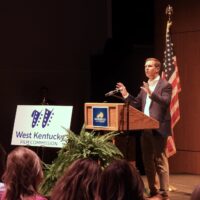Kentucky lawmakers are taking steps to bring nuclear power to the state, but the process won’t be quick.

A Senate joint resolution passed earlier this year created a working group made up of lawmakers, scientists, energy experts and environmental advocates. That group released a report in November detailing barriers to nuclear power generation in the Commonwealth and laying out recommendations for “providing a solid foundation for building the state’s capacity to engage in the nuclear energy ecosystem,” including the creation of a permanent nuclear energy development organization in Kentucky.
No “insurmountable barriers to nuclear energy development” in Kentucky were found in the report, though “cross-cutting issues” like education, workforce development and trust building were identified.
The report indicates that there are no regulatory or statutory barriers to nuclear power generation in Kentucky. It also advocated for the implementation of new utility and business models and partnerships in the state that could support nuclear energy.

State Sen. Danny Carroll, a Republican from Benton, said during a Paducah Area Chamber of Commerce event earlier this week that lawmakers were drafting legislation to create an authority based off of the recommendations outlined in that working group report.
“We want Kentucky to be at the front of nuclear industry and be open to nuclear … and we’re making pretty good strides in that area,” Carroll said. “Things are moving quickly in this country and we’ve got to get in front of that. I think the working group was the first step.”
Other strategies the group’s report said would make Kentucky a better environment for nuclear development include “focused, intentional work around [environmental] justice issues” in nuclear energy rather than simple public outreach and education programs, and aiding in the development of accredited nuclear engineering or nuclear technician programs at state colleges.
Kentucky’s nuclear future has a foothold in Paducah
The Bluegrass State’s relationship with atomic energy has been slow going.
The Paducah Gaseous Diffusion Plant was constructed in 1952 to enrich uranium for the nation’s nuclear weapons program and later for nuclear fuel for commercial power plants until it closed in 2013.
Maxey Flats, near Morehead, also played a role in nuclear development within the state. The inactive facility in eastern Kentucky was a low-level radioactive waste disposal site from 1963 to 1977.
Kentucky’s legislature passed a ban on the storage of spent nuclear fuel in the state in 1984. That moratorium – which prevented the creation of new nuclear reactor sites – came to an end after more than three decades in 2017 with the passage of the Robert J. Leeper Act, named for the former state senator from Paducah.
Carroll, who represents Leeper’s former district, sponsored the bill that ended the moratorium.

Cory Hicks works as the director of business services with the Four Rivers Nuclear Partnership – a group of three U.S. Department of Energy contractors formed to help handle the deactivation and remediation of the former Paducah nuclear site. Hicks, who also served as a part of the working group for the state, said there’s potential to bring the nuclear industry back to western Kentucky.
“For the longest time [in] Paducah, west Kentucky and McCracken County, it was this cone of secrecy because the Gaseous Diffusion Plant originally started to support the national security efforts and then pivoted to supporting commercial nuclear power,” Hicks said. “The plant has since closed back in 2013 … mainly because the technology is outdated, and [now] there’s new technologies that are out there. There’s an opportunity to use some of the assets that are here to support future reindustrialization and, because of the familiarity of nuclear, this area could be a key place where that could happen.”
The Paducah Area Chamber of Commerce is exploring that opportunity through a research project funded by a $2 million grant announced earlier this year.
Keeping Kentucky off the sidelines
The Kentucky Nuclear Energy Development Authority would serve as a non-regulatory agency helping to educate the public about nuclear energy issues and aiding in the development of the nuclear industry in the state alongside the Kentucky Cabinet for Economic Development and the Kentucky Energy and Environment Cabinet.
“In doing so, the Authority will support and facilitate the development of the nuclear energy ecosystem across the Commonwealth in a collaborative manner that enhances Kentucky’s economy, offers opportunities that are safe, protects the environment across the Commonwealth, supports community voices especially in under-represented or historically impacted areas, increases energy education, and prepares a future workforce,” the report reads.
The report also outlines a rudimentary structure for the agency consisting of a director, technical staff, students and administrative support, as well as a 21-member advisory board of stakeholders, experts, utility representatives, environmental advocates, lawmakers and other officials.

This authority’s recommended initial state budget appropriation stands around $750,000 – though the working group said it would need to increase to $900,000 in subsequent years.
Rodney Andrews is the director of the University of Kentucky’s Center for Applied Energy Research, where the proposed nuclear authority is expected to be housed. He said Kentucky needs to look into new nuclear power possibilities because of the potential economic gains and shifting environmental standards when it comes to power generation.
“You hear nuclear, and the first thing people think of is Three Mile Island and Chernobyl and other things that have happened, instead of the fact that it has an extremely high safety record, its service years of safe operation and … a lot of economic benefits,” Andrews said.
Andrews thinks Kentucky could capitalize on industry power demands by pursuing manufacturing, fuel production or processing and power generation through nuclear energy.
“Those have an appeal, as you see industry, particularly industry that has high power demands, looking to meet corporate emissions goals,” he said. “Nuclear can meet the demand, but also do that at, essentially, a very, very low emissions level.”
Climate scientists say that humanity must cut carbon emissions by half globally by 2030 and reach net-zero by 2050 to avoid the worst impacts of global warming. Andrews said nuclear energy is one of the most reliable ways to replace the electricity supplied by coal-fired power plants.
“As we see new regulation coming for the power industry, there are concerns around stable, reliable baseload power … the system that provides the bulk of your power, and allows you to then include renewables and other things on top because you have the stable base that can meet demand,” he said. “Nuclear provides that option if we’re moving away from the traditional fossil fuel powered systems.”
Time and money are driving factors in the reexamination of nuclear energy in Kentucky. The report states a desire on the working group’s part to “create an environment [in the state] that can match this movement in other states so it doesn’t get left behind,” which Andrews said is a concern of his.
“I would like to see Kentucky not be on the sidelines as things develop,” he said. “We want to be an active participant.”
Department of Energy statistics indicate that around 20% of electricity generated in the U.S. comes from nuclear power, but Kentucky still runs on coal. According to the Kentucky Energy and Environment Cabinet, 69% of the power generated in the state comes from the legacy fossil fuel.
Meanwhile, Kentucky’s border states are pushing forward with nuclear development.
Illinois leads the nation when it comes to nuclear reactors. The Land of Lincoln is home to 11 active reactors and has the highest total nuclear nameplate electricity generation capacity. Illinois lawmakers also recently approved legislation to advance the development of small modular reactors in the state. And, to the south, Tennessee could soon be home to the nation’s first mini nuclear power plant.
Editor’s note: Kentucky State Sen. Danny Carroll declined to be interviewed for this piece.
This story is republished with permission from WKMS. Read the original.






